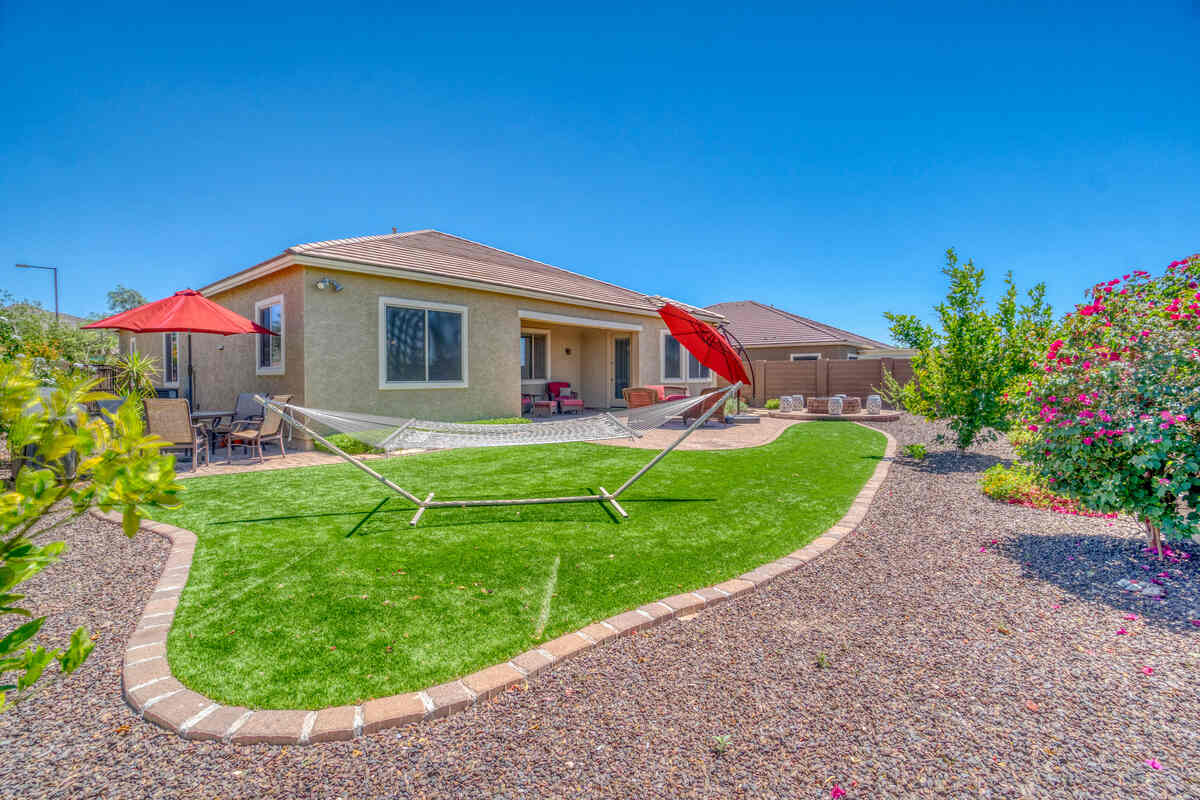
For over 100 days a year, the low southern deserts in the Grand Canyon State spend high noon at 100°F or more. In June, the average statewide rainfall is about 0.3 inches. This hot and dry summer makes it challenging to grow grass. However, if you know how to take care of your summer grass in Arizona, you can have a successful lawn despite the heat.
Driving around the streets of Phoenix, Mesa, or Tucson, you see lush and green turf all over the place, defying the scorching sun. That’s because there is a way to do efficient summer lawn care in Arizona: to water, mow, and fertilize like a pro. Here’s what you need to know to make your summer grass shine this year.
- Summer Lawn Care Depends on The Type of Grass
- The Best Summer Watering Schedule is a Flexible One
- Check the Irrigation System in Early Summer
- Keep Your Arizona Lawn Taller in the Summer
- Fertilize Every 4 to 8 Weeks
- Aerate During the Growing Season
- Remove Thatch From June to August
- Grasses with Special Requirements in Summer
- Keep Summer Weeds Under Control
- FAQ
Summer Lawn Care Depends on The Type of Grass
Arizona’s yards shelter both cold and warm-season grasses, depending on where you live:
- Homeowners in the Phoenix area and the low deserts mostly have Bermudagrass on their lawns for the summer. They overseed with winter grass (usually perennial ryegrass) in the fall.
- If you live in Flagstaff, Prescot, or Payson and see snow in the winter, you’ll have cool-season grass on your lawn, like tall fescue, Kentucky bluegrass, or ryegrass.
What summer lawn care looks like depends on the type of grass on your Arizona lawn. Native low-maintenance grasses, such as Blue grama or buffalograss, require less water and almost no fertilizers or mowing. So, summer lawn care is very relaxed. Bermuda and St. Augustine, on the other hand, are a bit more demanding.
See below the basic rules for a healthy lawn in the summer and how to tweak them to fit your grass type.
The Best Summer Watering Schedule is a Flexible One
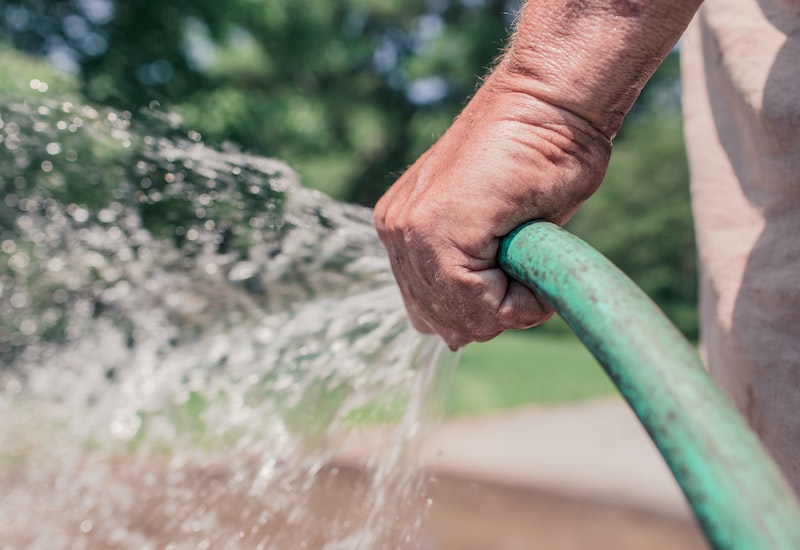
In the oven-hot and dry-as-nails Arizona summer, lawn love is tough love. You’ll want nothing more than to bathe the grass in fresh, cool water every evening. But you can’t. And you shouldn’t.
Your grass is as drought-tolerant as you train it to be. Overwatering keeps the roots shallow and makes the grass more vulnerable to heat and dry spells. It also opens the door for nasty fungal diseases, annoying weeds, and bugging pests. Underwatering is no good, either.
To get summer irrigation right and keep the turf green and healthy, you must know the following:
Best Time to Water the Lawn in the Summer
The best time to water the lawn in the summer is early morning, around 5:00 to 6:00 a.m. Watering at the crack of dawn gives the water a few hours to soak deep into the soil before the air heats up. Also, the mild morning sun evaporates all the drops left on the blades, reducing the risk of fungi.
The second best time is in the evening. You still avoid the high evaporation rate you’d deal with if watering mid-day, but the blades stay wet during the night and are exposed to diseases.
How Often to Irrigate the Grass in Summer
The basic rule to promote deep root growth is to irrigate no more than once every three days. Bermuda, St. Augustine, Zoysia, and Buffalograss have a good tolerance to drought and thrive if watered deeply and infrequently.
But your actual watering schedule depends on the soil, type of grass, amount of shade, and rainfall. The best approach is to observe the grass and irrigate when it shows the following signs of stress:
- About 30 to 40% of the blades wilt.
- The beautiful vibrant green color turns a bluish-grey tint.
- It takes longer to recover from foot traffic.
The Proper Amount of Water to Put on Your Lawn
Typically, your Arizona lawn needs about 1 to 1.5 inches of water per week (½ to ¾ inches per session). The golden rule is to ensure moisture penetrates the soil 6 to 10 inches deep each time you irrigate.
This way, water gets deep enough to be available for the grassroots and protected from the heat for a few days. Test the soil with a shaft or a screwdriver to check for moisture. You watered enough if you can easily get the tool into the ground at least 6 inches deep.
Since water absorption varies with soil type, you should also know that:
- If your garden has sandy soil, it will let water into its lowers layers faster, so you can apply more water at once.
- With clay soil, absorption is slow. You need to split each watering session in two with a 15 to 30-minute break to allow the water time to enter the soil.
Find out your lawn’s soil texture with a soil test. Collect samples across the yard and send them to the local Cooperative Extension office for analysis.
Signs Your Lawn Is Getting Too Much or Too Little Water
It takes time to get summer irrigation right, especially with a new lawn. Here are some signs that let you know if you’re putting down too much or too little water:
| Signs of Overwatering | Signs of Underwatering |
| • When you step on the lawn, the soil feels mushy and soft. • You smell a musty odor when you’re near the lawn. • Your lawn keeps having puddles. • The grass has algae or mushrooms. | • The grass turns a bluish-gray tint. • The turfgrass feels warm in the evening, even if the air is cooler and the sun is almost set. • The grass recovers its shape slower after foot traffic. |
Pro tips about watering a lawn in Arizona:
- Water any shaded areas about 30% less than areas in direct sunlight.
- Reduce water amount or delay irrigation if it rains.
- To irrigate correctly, ensure the sprinkler system is in good condition.
Check the Irrigation System in Early Summer
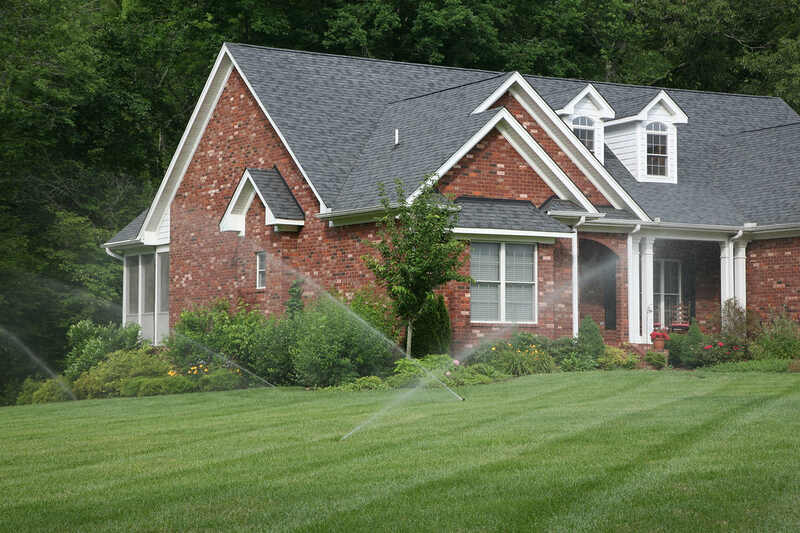
Nozzles can clog. Pipes can leak. Sprinkler heads can move into the wrong position. Check the irrigation system in early summer to ensure it functions correctly and repair what is broken. Here are three rules for good sprinkler coverage for your turf:
- Three sprinkler heads must water every area.
- Water coverage should go all the way from one sprinkler head to the next.
- All sprinkler heads are in good condition and pointing in the right direction.
Pro tips about an efficient irrigation system for Arizona lawns:
- Use the same type and size of sprinkler nozzles on the entire lawn.
- Direct all sprinklers to water the grass (not driveways or walkways).
- Consider adding an extra sprinkler if some areas don’t get enough water.
Keep Your Arizona Lawn Taller in the Summer
Whether parenting a lawn in the low Phoenix area or up in Flagstaff, summer is the time to set the lawn mower blades slightly higher. Taller blades grow deeper roots, protect soil moisture from evaporation, and shade the grass stems from direct sunlight.
The Right Mowing Height for Summer
The ideal summer mowing height varies with the type of grass on your lawn. Below are the recommended levels for Arizona’s most common turf types. During the summer, use the higher end of the interval.
| Type of Grass | Recommended Mowing Height |
| Bermudagrass | 0.5 to 2.5 inches |
| Buffalograss | 2.0 to 3.0 inches |
| St. Augustinegrass | 3.5 to 4 inches |
| Zoysiagrass | 1.0 to 2.0 inches |
| Blue grama | 2.0 to 3.0 inches |
| Perennial ryegrass | 1.5 to 2.5 inches |
| Tall fescue | 2.5 to 3 inches |
| Kentucky bluegrass | 2.5 to 3.5 inches |
Always cut ⅓ of the grass’s height or less. When you cut more, the grass recovers slower and is vulnerable to heat stress, drought, pests, and diseases. Don’t scalp your lawn during the summer.
Late spring to early summer is a good time to plant grass. If you’re a proud new lawn owner, wait until the turf reaches the maximum recommended height or about 0.5 inches taller before the first mow. For example, with Bermudagrass, wait until it’s 2.5 to 3.0 inches tall.
How Often to Mow the Lawn in Summer
A good mowing rhythm for Arizona lawns this time of year is 2 to 4 times a month. It also depends on the growth rate. Mow the grass often enough to keep the right height while following the ⅓ trimming rule discussed above.
The Best Time to Mow the Lawn During Summer
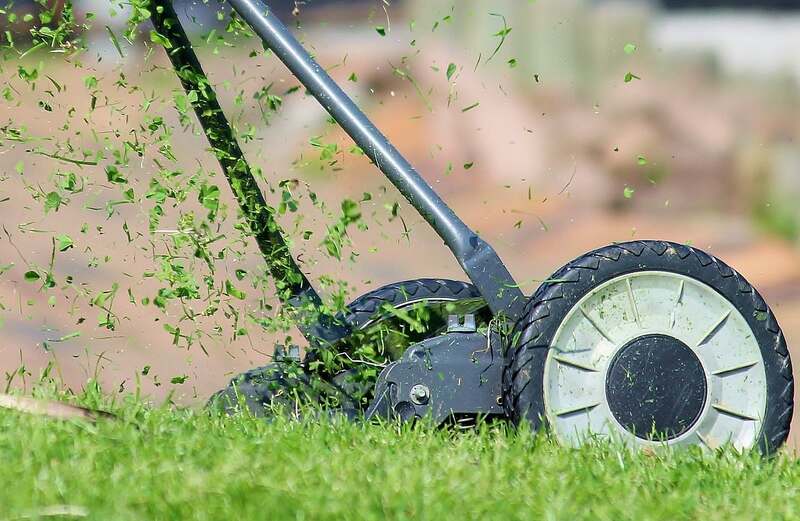
Plan lawn mowing for the early morning after the dew has dried out. Your purpose here is to avoid cutting wet grass and give the plants a few hours to heal before the mid-day sun is up.
You can also mow late in the afternoon after the sun’s peak – but not too late, so the grass still catches some sunlight after trimming to heal the cut.
Pro tips about mowing summer grass in Arizona:
- Avoid mowing after rain or watering.
- Keep the lawn mower blades sharp. A clean cut heals easier.
- Take a different route every time you mow, especially if your lawn has clay soil. This way, you avoid compacting the ground.
- Leave the grass clippings on the lawn. They’ll release nitrogen, keeping the grass healthy and green.
Fertilize Every 4 to 8 Weeks
Arizona desert soils are low in nitrogen and organic matter. The high pH and calcareous composition also make iron, zinc, and phosphorus less available to plants. But the deficits are not the same all over the state. A yearly soil test is a good way to:
- Better assess your lawn’s specific needs.
- Figure out if the soil needs a pH adjustment.
- Feed the grass with the best mix of nutrients during the growing season.
The Best Fertilizer for Summer Lawns
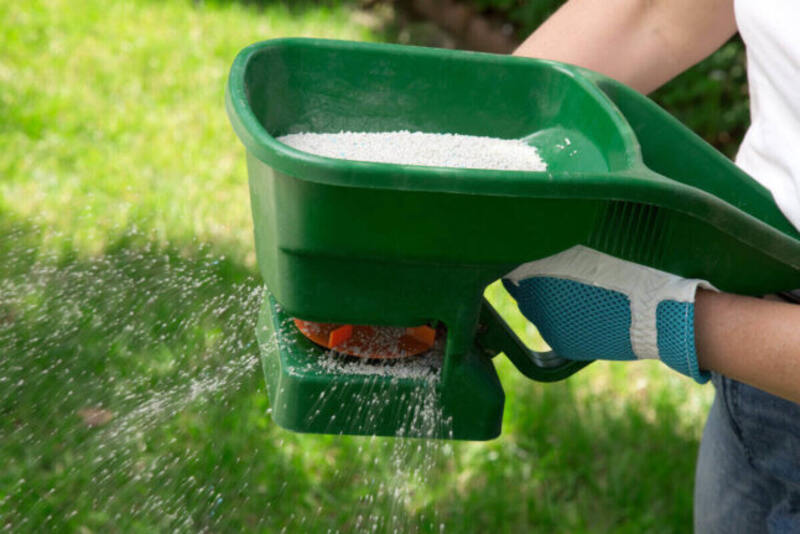
For established lawns, choose a slow-release formula richer in nitrogen to promote leaf growth. Look for a product with added iron or apply it separately. If the soil has a high pH, use a foliar iron solution for better results.
For a new lawn, use a starter fertilizer with more phosphorus and potassium and less nitrogen. Such a product helps the grass roots develop and improves the plant’s resistance to diseases and stress.
Fertilize with ½ lb. of nitrogen per 1000 square feet between April and September, once every 4 to 8 weeks. You’ll need to determine the right frequency by observing the grass’s appearance. See below some telling signs to keep an eye on.
| Under-fertilized Lawn | Over-fertilized Lawn |
| • Thinned lawn • Light-green to yellowish color • Recovers slowly from foot traffic | • Grows faster than usual • Needs mowing and watering more often • Produces a lot of thatch buildup |
When To Fertilize During Summer
Fertilize in the early morning or evening and water the lawn thoroughly to ensure nutrient absorption. A broadcast spreader will help you distribute the nutrients uniformly across the lawn.
Split the fertilizer amount in two. Spread one half in one direction and the other perpendicularly to ensure good coverage.
Avoid fertilizing in late spring and early summer if you overseeded the lawn with winter grass.
Aerate During the Growing Season
Soil compaction is a common problem in Arizona, where the soil is rich in clay. Compacted soil is dense and tough, and grassroots struggle to grow through it. It also limits air and water movement toward the roots, and the turf is weaker, thinner, and more susceptible to diseases and heat stress.
The best way to solve the problem is to aerate the lawn. Core aeration pulls out soil plugs all over the lawn. It makes many holes that help air, water, and nutrients get into the ground and to the roots.
As with most other mechanical treatments, going with a core aerator over the lawn can damage the grass. That is a good reason to always aerate during the growing season so the plants can recover quickly.
Remove Thatch From June to August
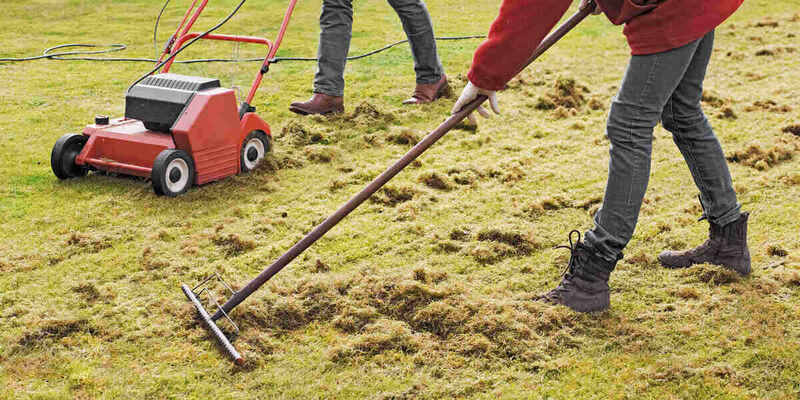
June to August is ideal for you to dethatch or vertically mow the lawn. Nighttime temperatures are above the mid-60s, and the grass is thriving and growing. Bermuda, St. Augustine, and Zoysia spread robust stolons across the yard and can recover quickly from mechanical damage and foot traffic.
Thatch covers the soil in a dense layer of:
- Fallen leaves
- Dead grass
- Dry roots
- Other organic debris
When thatch is thicker than ¾ inch, you need to get rid of it. Otherwise, it keeps water, air, and nutrients from reaching the ground and grass roots.
Use a power rake (aka dethatching machine or verticutter) to remove the build-up. Power rakes have sharp knives that slightly dig into the thatch layer. They cut and pull out the debris, so you can easily rake them afterward.
Pro tips for dethatching an Arizona lawn:
- Schedule dethatching before a fertilization session. Nutrients are absorbed easier after removing the thatch and help the grass recover faster.
- Use a broadcast spreader to apply the fertilizer uniformly.
Grasses with Special Requirements in Summer
Not all summer grasses have the same fertilization and watering needs, and it’s important to adapt to their requirements. Let’s see some examples.
- Palmetto St. Augustine has low nitrogen requirements. Feeding it at half the rate recommended for other grass varieties is best. If you fertilize too much, it becomes prone to thatching and diseases. Also, use fertilizers rich in potassium and magnesium.
- Celebration Bermuda is a natural dark green. It needs less nitrogen and iron than other Bermuda varieties to keep a good, intense color.
- Zoysia is particularly sensitive to alkalinity. To keep a beautiful Zoysia lawn in Phoenix, Mesa, Yuma, Tucson, and other communities in the low southern deserts, you must keep an eye on the soil’s pH and fertilize with iron more often.
- Blue grama and buffalograss grow naturally across Arizona and adapt well to the local soils without much watering and added nutrients.
You don’t have to know all the details by heart. There are excellent lawn care experts across Arizona who can help you determine the perfect summer treatment for your lawn.
Keep Summer Weeds Under Control
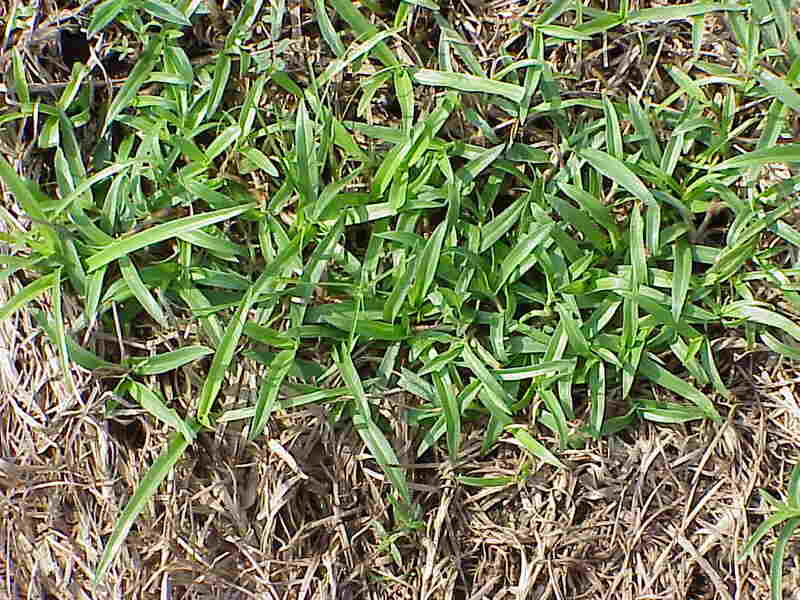
The best way to manage weeds in your Arizona lawn is to keep the grass healthy, thick, and tall. With dense, lush turf:
- Weed seeds reach the soil less often.
- The soil is in the shadow of the grass, and weed seeds fail to germinate.
- Weed seedlings have a hard time growing since they compete with healthy grass for water and nutrients.
Problems appear when the grass is thinned, and the lawn shows bare patches. Weeds like spurge and barnyard grass start to emerge, flower, and seed within a few weeks.
To keep these summer weeds at bay:
- Apply a pre-emergent herbicide during spring.
- Treat stressed lawn patches with fertilizer and some extra water.
- Be careful where the water and fertilizer runoff land. They might promote weeds near the lawn and later send seeds into the turf.
FAQ About Summer Lawn Care In Arizona
The key to growing healthy, green grass in Arizona is promoting a deep, extensive root system by watering deeply and less frequently. Start by irrigating no more than once every three days and adapt to rainfall and your grass’s needs.
Use a fertilizer with slow-release nitrogen every 4 to 8 weeks on a healthy lawn. Choose a formula with added iron or apply the iron separately.
To maintain a beautiful lawn in Arizona during the summer, do the following:
• Aerate compacted soil and dethatch when necessary.
• Water deeply once every three days or less.
• Mow to the right height and keep the blade sharp.
• Apply a suitable fertilizer with slow-release nitrogen and iron.
• Keep weeds under control.
To keep the grass healthy and green in Arizona during summer, follow this watering schedule:
• Water once every three days in June and July.
• Water once every four days in August.
• Irrigate shaded areas 30% less than sunny areas on your lawn.
• Reduce irrigation when it is raining.
To help the grass establish proper roots, water new lawns daily during the first few weeks. A basic watering schedule to promote emergent seedlings looks like this:
• Water 4 to 5 times a day until germination.
• Reduce watering to 2 or 3 times a day for the next two weeks.
• Water once a day for the following two weeks.
• Slowly reduce irrigation until you follow the regular watering schedule of once every three days.
The first step to keeping plants alive in summer in Arizona is choosing the right plants. The dry, hot summers of the Southwest are just too intense for many plants, and they don’t survive no matter what you do. Check out our list of the best plants for Arizona heat to help you choose plants that can not only survive but thrive in summer.
Enjoy Your Green, Lush Arizona Lawn All Summer!
Growing green grass in Arizona during its torrid, crisp summers is a serious commitment. You need to water deeply every time, mow taller and quite often, and use the right amount and type of fertilizer about once a month.
But you don’t have to do it alone. Whatever challenge you’re facing with your Arizona summer grass, there’s always a lawn care expert nearby to lend a hand. In Phoenix, Mesa, Glendale, Scottsdale, and everywhere in the Grand Canyon State, LawnStarter can connect you with the best pros to keep your lawn healthy all summer long.
Main Image Credit: Shutterstock